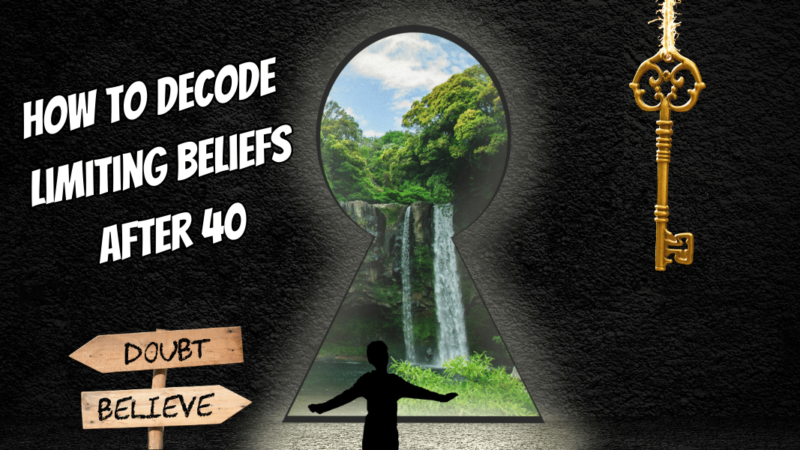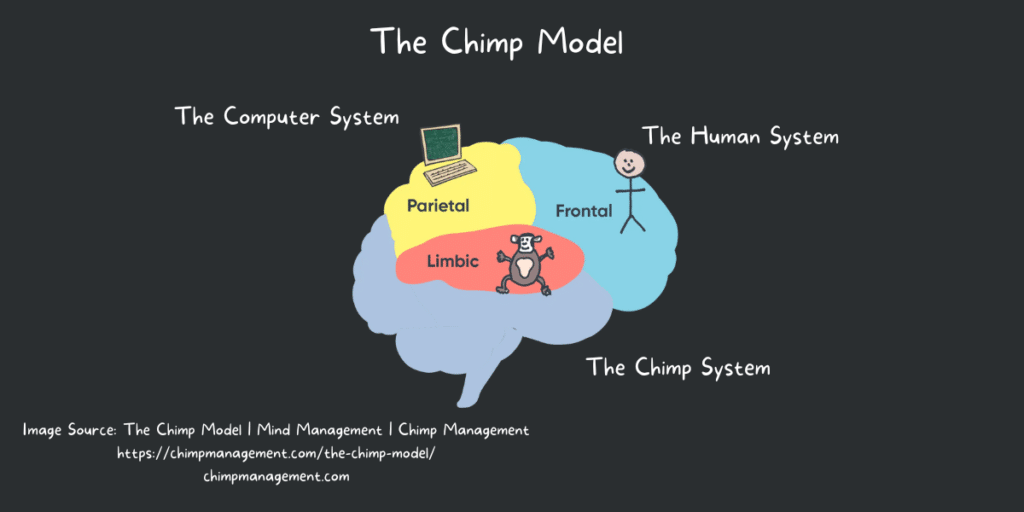How to Decode Limiting Beliefs After 40: Unlocking the Power Within
Life brings challenges, and in our 40s, some of these come from self-doubt. These doubts, or limiting beliefs, can hinder us from reaching our full potential. But don’t worry if you’re dealing with limiting beliefs after 40. You can get past them!
Notably, a helpful model that I’ve recently started using to understand better my own thoughts, feelings, and emotions comes from Professor Steve Peter’s – ‘Chimp Paradox.’ He presents an idea where our mind consists of three teams:
• A logical ‘human’ driven by facts,
• An emotional ‘chimp’ reacting impulsively, and
• A ‘computer’ that archives our experiences.
It’s important to note that the chimp, often the most vocal, expresses our doubts and fears but doesn’t always represent the truth. However, we can learn techniques to manage and soothe our chimp, leading to a better understanding of our internal doubts.
In this post, we aim to help you understand:
- What makes you doubt yourself?
- Where these doubts originated and how they impact you.
Furthermore, we’ll delve deep into the nature of limiting beliefs after 40, their origins, their influence on our behavior, and their mechanics. Let’s get going and start the move beyond doubts and embrace a more fulfilling life.
What Are Those Doubts Holding You Back? Understanding Limiting Beliefs
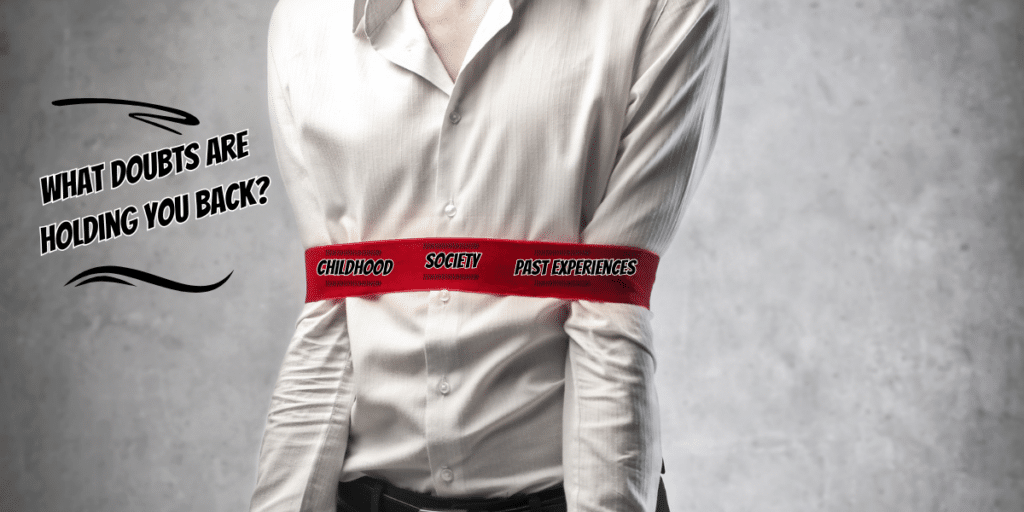
Limiting beliefs are thoughts that make you think you can’t achieve something. These thoughts can make you question yourself and keep you from pursuing your dreams.
For instance, you might feel you’re not smart enough to start a business or that you’re too old to try a new job in your 40s. These feelings can keep you from taking steps toward your goals.
Where Do These Doubts Come From?
- Childhood: Sometimes, these doubts start when you’re a kid. Maybe parents, teachers, or friends said things that made you feel limited.
- What Others Think: Society tells us what’s “normal” or “right.” This can make us think we should act or be a certain way because of our background or where we come from.
- Past Experiences: If you tried something that didn’t work out, you might think you’ll fail again.
Additionally, the ‘chimp’ in our brains plays the role of an emotional entity that often reacts impulsively. This chimp can be the origin of many of the doubts holding us back, forming beliefs not necessarily based on reality but on emotional reactions.
But the good news is you can challenge these doubts! By understanding their origins, you can think differently and put in place belief strategies to achieve your dreams, regardless of age.
How Doubts Affect Your Daily Choices
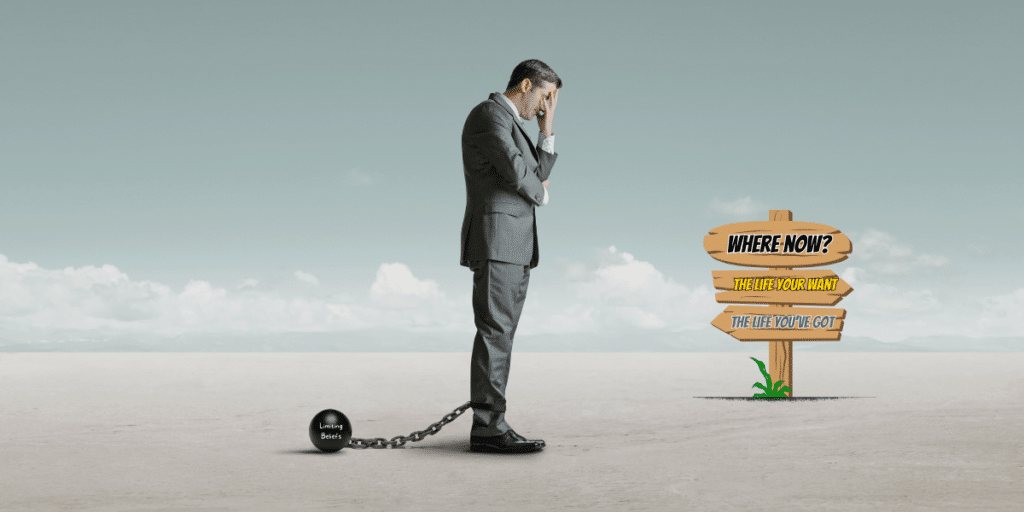
How These Thoughts Show Up in What We Do
It’s common for limiting beliefs to sneak into your everyday life, changing the choices you make.
For example, maybe you’re scared to try new things because you don’t want to mess up. This fear could make you miss out on fun experiences. These beliefs can also make you question yourself or feel nervous about what might happen next.
In making choices, these beliefs might make you pick what’s safe over what you really want. This can keep you from doing your best and reaching your goals.
Examples of Limiting Beliefs After 40
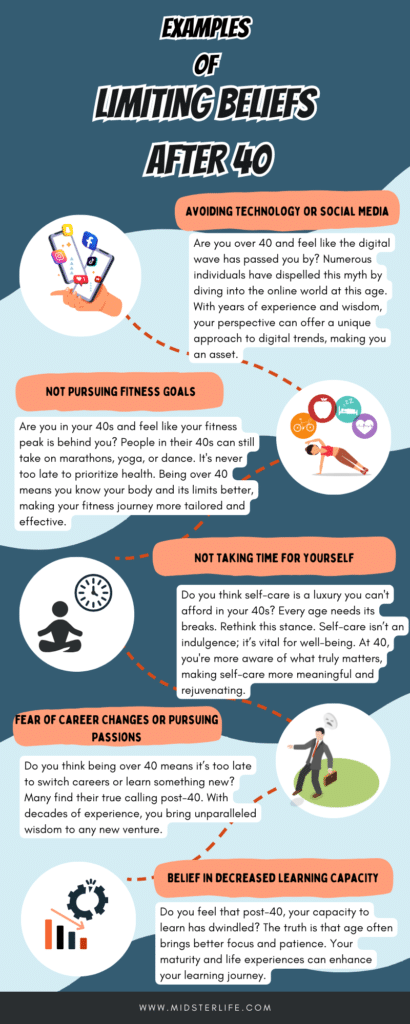
Examples of limiting beliefs after 40:
- Avoiding Technology or Social Media: Some in their 40s feel they’ve missed the “tech wave,” and it’s too late to catch up. This doubt can prevent them from exploring new tools and platforms or even starting an online side hustle. Yet, many individuals have successfully dived into the digital world in their 40s and beyond, embracing its opportunities.
- Not Pursuing Fitness Goals: People sometimes believe they’re past their physical prime by their 40s, and it’s too late to get in shape or try a new sport. This doubt can prevent them from adopting a healthier lifestyle or exploring new physical activities. But age isn’t a barrier to fitness; numerous stories of individuals taking up marathons, yoga, or even dance in their 40s prove it’s always possible to prioritize health.
- Not taking time for yourself: If you think you shouldn’t rest or it’s a waste of time, you might not take care of yourself. But everyone needs a break to do their best.
You can make better choices that help you grow by identifying and challenging these thoughts. Even in your 40s and later, you can change your story and go for what you want.
How Limiting Beliefs Work
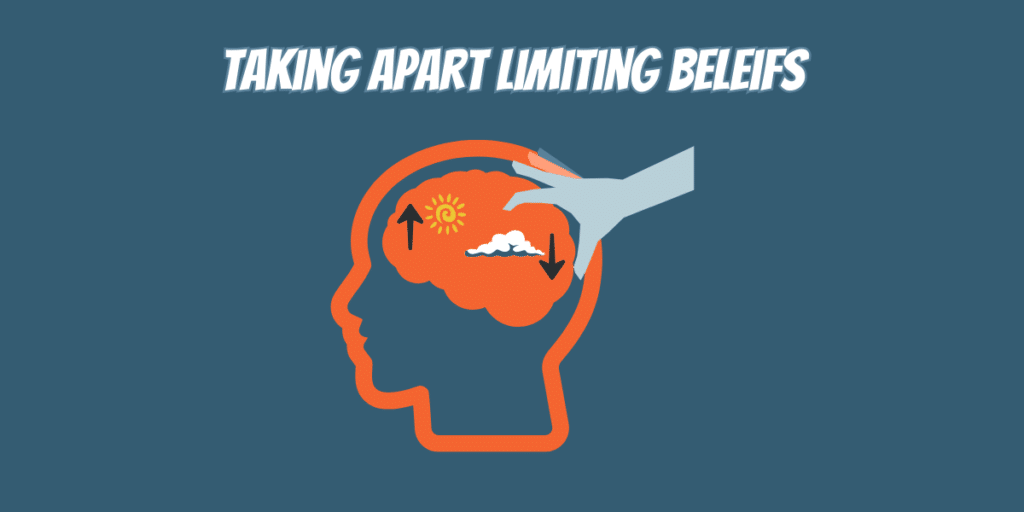
Taking Apart Limiting Beliefs After 40
To move past our limiting beliefs after 40, we need to figure out where they come from. Think about a belief that holds you back and ask yourself, “Why do I think this?” Test out if what you believe is really true. Think about other ways to see it. Remember, sometimes, our beliefs might not fit with what’s happening right now.
What’s Real vs. What We Think
Knowing the difference between what’s real and what’s just in our heads is vital. Real things are facts that everyone agrees on. What’s in our head, our beliefs, comes from our own experiences and feelings. For example, everyone agrees the Earth goes around the Sun. But thinking “I’m bad at math” is just a belief. Sometimes, if we don’t base our beliefs on real facts, they can hold us back.
Likewise, in our mind, the chimp often struggles with discerning reality from emotional reactions. It can easily mistake feelings for facts, leading to beliefs not anchored in reality.
Example:
Imagine you’re at a work event, and you see a colleague across the room. You try to start a conversation, but they seem distracted and don’t chat much. You might immediately think: “Did I make a mistake in the last meeting? Are they upset with me? Maybe they don’t like me anymore.”
This is the “chimp” in your mind jumping to conclusions based on emotions, not facts. In reality, your colleague might be having a busy day or worried about something else.
How Feelings and Memories Make Beliefs Stronger
The chimp, driven primarily by emotions, often clings to past memories, especially those that elicit strong emotions. It might take a single past setback as proof of an unchangeable reality, even if it’s an isolated event.
For example, if you had a hard math test as a kid, you might think you’re bad at math. That thought could stop you from trying things that use math in the future.
Understanding our feelings and past experiences can help us move past these beliefs. Just because something happened once doesn’t mean it’ll happen again. As we get older, even in our 40s, we can change how we think and try new things.
Simple Ways to Spot and Beat Limiting Beliefs After 40
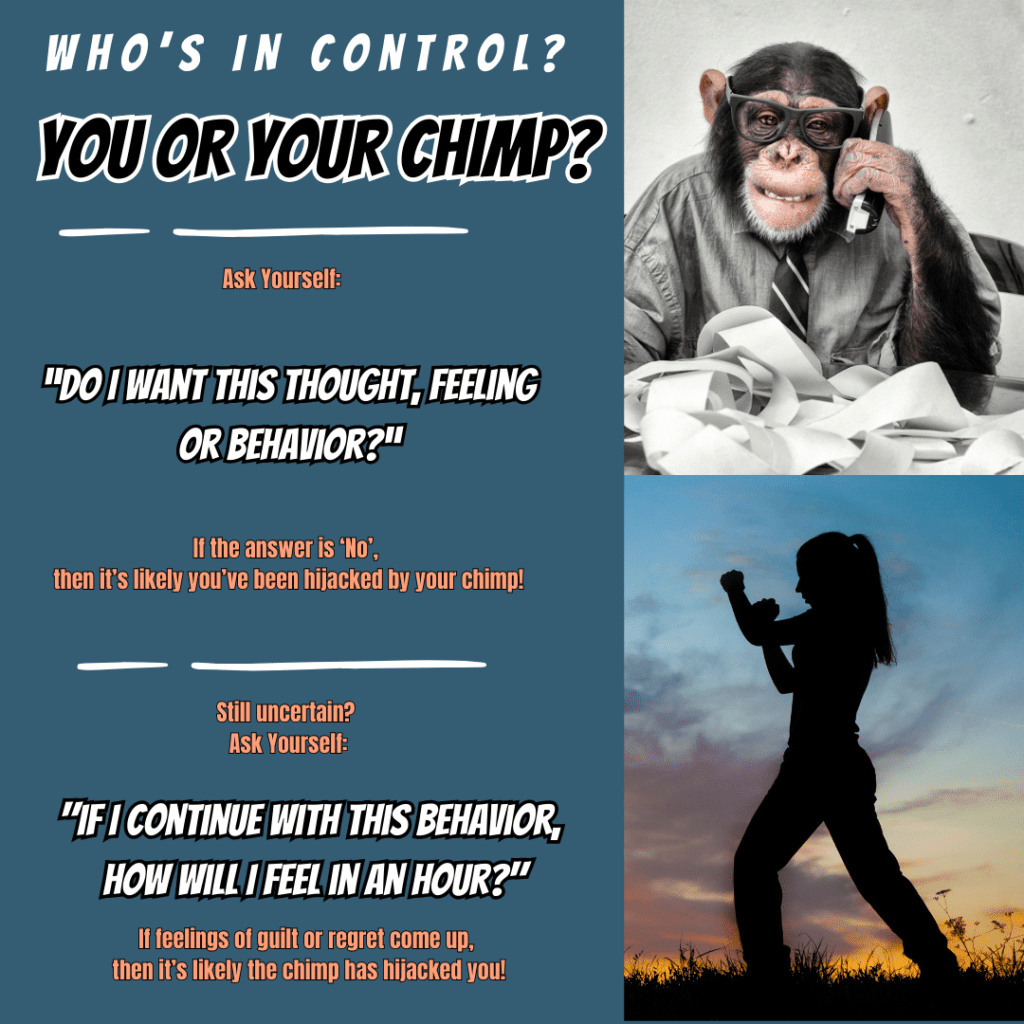
Recognizing the signs of the chimp’s emotional reactions is crucial. The chimp might be what makes you shy away from challenges due to past failures or fears. Understanding its influence can help you spot and tackle the barriers it sets up.
A helpful strategy suggested by Prof Steve Peters’ in “A Path Through The Jungle” to determine if your chimp is steering your thoughts, feelings, and actions is to ask: “Do I want….?”
“Do I want this thought?”
“Do I want to feel this way?”
“Do I want to behave this way?”
If the answer is “no,” it’s a sign that the chimp is in control.
Still uncertain?
Pose a follow-up question to yourself: “If I continue with this behavior, how will I feel in an hour?”
If feelings of guilt or regret come up, then it’s likely the chimp has hijacked you!
Ways to Know Your Limiting Beliefs After 40
Knowing your limits involves an internal dialogue between the logical ‘human’ and the emotional ‘chimp’ in your mind. While the chimp might resist, thinking it’s protecting you, the human side seeks growth and potential.
Try these activities to understand your limits better:
- Thinking Deeply About Yourself: To understand what’s holding you back, try writing in a journal, sitting quietly and thinking, or asking yourself tough questions. For example, when did you feel you couldn’t do something? What were you thinking at that time? Write down the thoughts that come up a lot. They can show you what’s really stopping you.
- Listening to Friends or Teachers: Sometimes, we don’t see what’s stopping us. That’s when close friends or teachers can help. Pick someone you trust and ask them, “What do you think holds me back?” Listen carefully. Even if it’s hard, this can show you things you might not have seen.
Signs You May Have Limiting Beliefs After 40
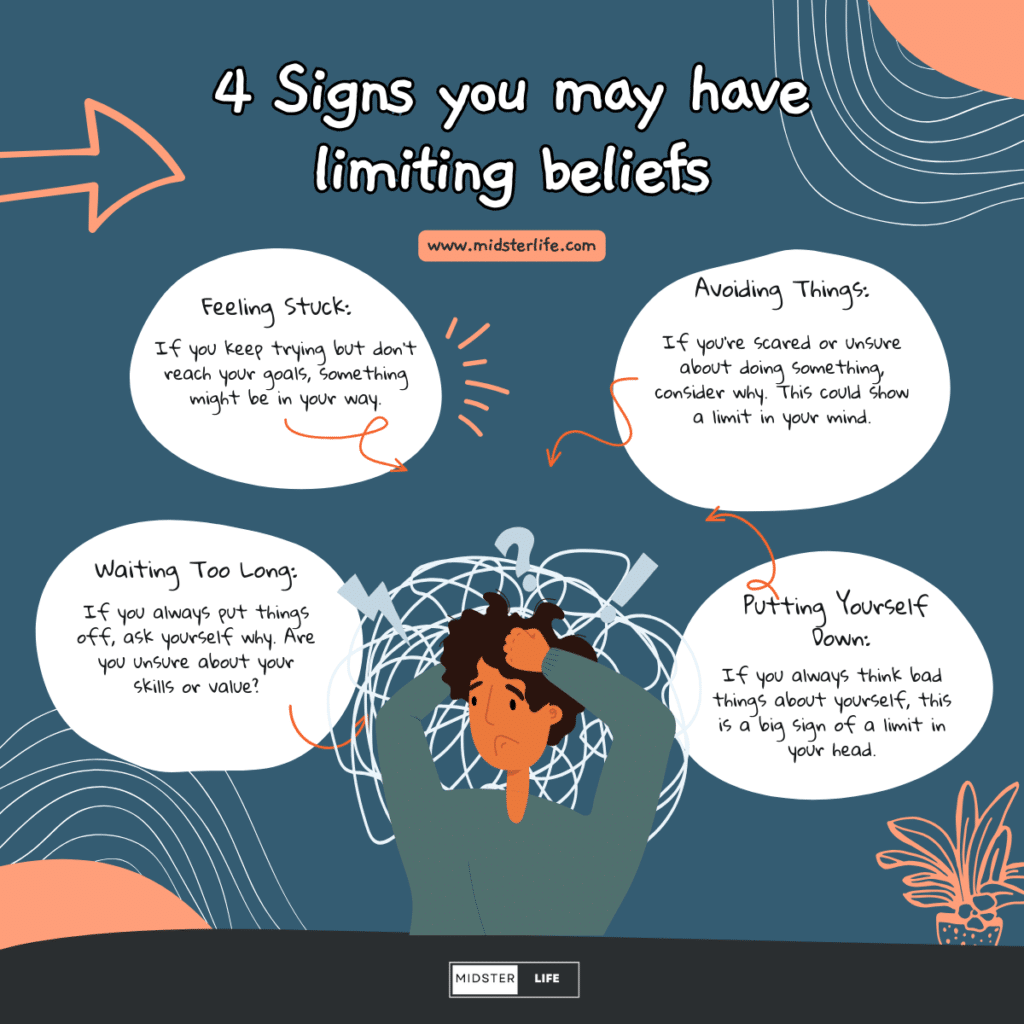
- Feeling Stuck: Something might be in your way if you keep trying but don’t reach your goals.
- Avoiding Things: If you’re scared or unsure about doing something, consider why. This could show a limit in your mind.
- Waiting Too Long: If you always put things off, ask yourself why. Are you unsure about your skills or value?
- Putting Yourself Down: If you always think bad things about yourself, this is a big sign of a limit in your head.
If you want to beat these limits, especially as you age, start by knowing what they are. Use writing, thinking, and talking to friends. Once you know what’s stopping you, you can learn how to think differently. This can help you grow and feel better about yourself.
In wrapping up, understanding limiting beliefs after 40 is crucial to unlocking our full potential. By understanding the ‘Chimp Paradox’ and recognizing how our internal ‘chimp’ can hold us back, we can reshape our perspectives. But merely identifying these limiting beliefs is only the beginning.
To truly overcome them and change the trajectory of our lives, we need actionable strategies to help us confront these beliefs head-on.

